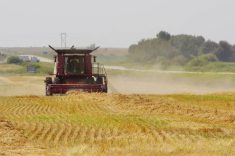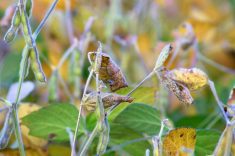Glacier FarmMedia – Horst Bohner is convinced that farmers should plant more than one variety of soybeans. If they don’t, they are making a “mistake.”
“As a basic starting point, I think every grower should seed at least three varieties. Every year. As a minimum. Hopefully more than that,” said Bohner, a soybean specialist for Ontario’s Ministry of Agriculture, Food and Rural Affairs.
Why it matters: Advice suggests that Manitoba growers might face problems if they hang their soy hopes on a single variety each year.
Read Also

Manitoba boosts stake in cereals centre to $23.5 million
Premier Wab Kinew said the additional project funds will help ‘Trump-proof’ the provincial economy.
Bohner spoke about soybeans, yields and management of the crop at the Manitoba Agronomists’ Conference held in mid-December at the University of Manitoba.
A more diverse soy mix is the major difference between farmers who are getting ahead and those who call him, frustrated with their yields, he said.
To support his argument, Bohner presented data on soybean yield gains from 1942 to 2022 in Ontario. The average yield gain over those 80 years was 0.36 bushels per year. When that number is cross analyzed with soybean variety trials in Ontario, data shows most of the gain comes from plant genetics.
“When we plot our variety trials over the years, and they go back to the 1960s, the average response [increase] there is 0.33 bu.,” he said.
That suggests 90 per cent of yield gain, year over year, comes from genetic improvement, he argued.
“We don’t have exact numbers to tease that out. It’s a best estimate,” Bohner said.
That doesn’t mean on-farm practices like seeding date, fertility and weed control are meaningless. If a grower gets those wrong, there will certainly be an impact on yield.
But with yield capacity carrying such a heavy genetic component, Bohner said there is danger if the farmer bets everything on a single variety. That might not be the variety best suited for that farm’s conditions, region or soil type.
“That’s what I’m trying to push against. I think that’s a big mistake.”
Planting three or four varieties doesn’t “guarantee more bushels,” Bohner added, but the potential for gains are there. It will also help a grower understand what works on their farm.
Those three varieties don’t need to be evenly split, “but you should, for your own learning, have a few varieties in there …. It’s a nuisance. Let’s be honest. [But] it’s a good practice.”
Agronomics
Outside of the critical genetic choice, producers in both Manitoba and Ontario have been changing their field management.
In many parts of Ontario, for instance, producers are moving away from no-till soybeans. That’s due in no small part to the hassle of corn residue management earlier in the rotation. Corn yields in the province are huge, and managing those stalks becomes a massive challenge if a farmer hopes to plant soybeans after a 220-bu. corn crop.
“I’m not a big fan of tillage for soybeans, but I am a huge proponent of dealing with the residue …. Heavy residue is the enemy of big soybean yields,” said Bohner.
Most producers in his region of southwestern Ontario have “gone back to some form of incorporation, whether it is a high-speed disc or vertical tillage.”
Soybean growers in both provinces have also changed, or will soon change, their approach to weed control. For many years, they relied solely on glyphosate to keep weeds in check. Those days are over.
“At one time, people would just spray it and forget about it. Now, you spray, go back and see if you have any misses,” said Dennis Lange, soybean and pulse specialist with Manitoba Agriculture and another conference speaker.

Lange showed a map illustrating how waterhemp, first discovered in Manitoba in 2017, has rapidly spread across the province.
“We now have 22 confirmed [municipalities] that have waterhemp. It’s a little scary when you walk out there and see those fields.”
Almost all waterhemp in Manitoba is resistant to glyphosate, and some plants may be resistant to multiple herbicides. It is designated as a Tier 1 noxious weed in Manitoba and must be destroyed when found.
Waterhemp can be managed, but experts have warned soybean growers and other farmers that they need to adapt.
In 2023, Lange said, farmers who had waterhemp issues tended to plant Enlist or Xtend soybeans. Those varieties tolerate two or three types of herbicides. Enlist beans have tolerance for glyphosate, 2,4-D choline and glufosinate. Xtend beans can tolerate glyphosate, dicamba and glufosinate.
When producers opted for glyphosate alone, “all of a sudden, they gave us a call,” Lange said.
The “waterhemp plants were up to [their] knees …. Glyphosate only can run you into problems.”
– Robert Arnason is a reporter for The Western Producer.
















